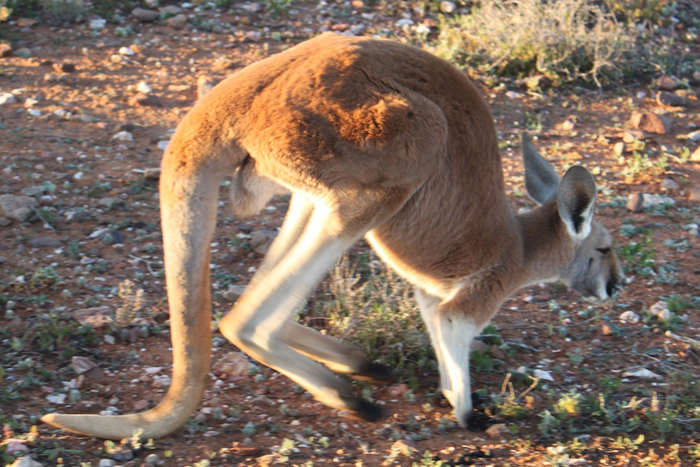Extra Leg? Kangaroos Walk with a Little Help from Their Tails

Five legs are better than four for kangaroos. A new study finds that 'roos use their tail as an extra leg when walking.
Though kangaroos are famous for hopping, they actually get around more often by walking on all four legs, including their small, armlike front legs. This "pentapedal" gait gets a major boost from the tail, researchers reported Tuesday (July 1) in the journal Biology Letters.
"When kangaroos are walking pentapedally, which they spend more time doing than hopping, they use their tail just like a leg," study researcher Shawn O'Connor, a postdoctoral fellow at Simon Frasier University in Canada, wrote in a FAQ on the research on the lab website. "In fact, they performed as much mechanical work with their tail as we do with one of our legs." [See Video and Images of Kangaroos Walking With Their Tails]
Kangaroo gait
O'Connor and his adviser, Max Donelan, a Simon Frasier University biomechanics researcher, study the details of human and animal locomotion in an effort to advance prosthetics and therapies for people who have had strokes or injuries that interfere with their gait.
"Unusual gaits by unusual animals, such as pentapedal walking by kangaroos, provide insight into the breadth of solutions available to the same biomechanical problem of getting from one place to another," Donelan wrote in the FAQ.
Researchers had observed that kangaroos plant their tails when walking pentapedally, but the reason remained a mystery.
Get the world’s most fascinating discoveries delivered straight to your inbox.
A new use for a tail
Surprisingly, the results showed the tail generated more propulsive force than the front and back limbs combined to move the kangaroo forward.
"During pentapedal gait, the kangaroo's more than 20 tail vertebrae take on the roles of our feet, calf and thigh bones," O'Connor wrote.
This is the first known example of an animal using its tail as a leg, Donelan added.
The importance of being able to push off with one limb while transitioning from one stance to another can't be understated. People with gait problems struggle with this ability, Donelan said in a statement, adding that it's interesting to find kangaroos have solved the problem by using their tails.
Kangaroo hops are "incredibly fast, powerful and efficient," Donelan wrote. "Their walking, on the other hand, is as awkward as their hopping is graceful, but underlying the walking gait is this entirely new use for a tail."
Follow Stephanie Pappas on Twitter nd Google+. Follow us @livescience, Facebook & Google+. Original article on Live Science.

Stephanie Pappas is a contributing writer for Live Science, covering topics ranging from geoscience to archaeology to the human brain and behavior. She was previously a senior writer for Live Science but is now a freelancer based in Denver, Colorado, and regularly contributes to Scientific American and The Monitor, the monthly magazine of the American Psychological Association. Stephanie received a bachelor's degree in psychology from the University of South Carolina and a graduate certificate in science communication from the University of California, Santa Cruz.


